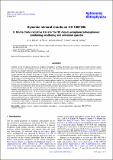Files in this item
Dynamic mineral clouds on HD 189733b. II. Monte Carlo radiative transfer for 3D cloudy exoplanet atmospheres : combining scattering and emission spectra
Item metadata
| dc.contributor.author | Lee, G. K. H. | |
| dc.contributor.author | Wood, K. | |
| dc.contributor.author | Dobbs-Dixon, I. | |
| dc.contributor.author | Rice, A. | |
| dc.contributor.author | Helling, Ch. | |
| dc.date.accessioned | 2017-06-08T15:30:19Z | |
| dc.date.available | 2017-06-08T15:30:19Z | |
| dc.date.issued | 2017-05-01 | |
| dc.identifier | 250203876 | |
| dc.identifier | 917a2271-262c-480c-9643-f3a6bb9b6468 | |
| dc.identifier | 85018608183 | |
| dc.identifier | 000402313500022 | |
| dc.identifier.citation | Lee , G K H , Wood , K , Dobbs-Dixon , I , Rice , A & Helling , C 2017 , ' Dynamic mineral clouds on HD 189733b. II. Monte Carlo radiative transfer for 3D cloudy exoplanet atmospheres : combining scattering and emission spectra ' , Astronomy & Astrophysics , vol. 601 , A22 . https://doi.org/10.1051/0004-6361/201629804 | en |
| dc.identifier.issn | 0004-6361 | |
| dc.identifier.uri | https://hdl.handle.net/10023/10952 | |
| dc.description | G.L. and Ch.H. highlight the financial support of the European community under the FP7 ERC starting grant 257431. | en |
| dc.description.abstract | Context. As the 3D spatial properties of exoplanet atmospheres are being observed in increasing detail by current and new generations of telescopes, the modelling of the 3D scattering effects of cloud forming atmospheres with inhomogeneous opacity structures becomes increasingly important to interpret observational data. Aims. We model the scattering and emission properties of a simulated cloud forming, inhomogeneous opacity, hot Jupiter atmosphere of HD 189733b. We compare our results to available Hubble Space Telescope (HST) and Spitzer data and quantify the effects of 3D multiple scattering on observable properties of the atmosphere. We discuss potential observational properties of HD 189733b for the upcoming Transiting Exoplanet Survey Satellite (TESS) and CHaracterising ExOPlanet Satellite (CHEOPS) missions. Methods. We developed a Monte Carlo radiative transfer code and applied it to post-process output of our 3D radiative-hydrodynamic, cloud formation simulation of HD 189733b. We employed three variance reduction techniques, i.e. next event estimation, survival biasing, and composite emission biasing, to improve signal to noise of the output. For cloud particle scattering events, we constructed a log-normal area distribution from the 3D cloud formation radiative-hydrodynamic results, which is stochastically sampled in order to model the Rayleigh and Mie scattering behaviour of a mixture of grain sizes. Results. Stellar photon packets incident on the eastern dayside hemisphere show predominantly Rayleigh, single-scattering behaviour, while multiple scattering occurs on the western hemisphere. Combined scattered and thermal emitted light predictions are consistent with published HST and Spitzer secondary transit observations. Our model predictions are also consistent with geometric albedo constraints from optical wavelength ground-based polarimetry and HST B band measurements. We predict an apparent geometric albedo for HD 189733b of 0.205 and 0.229, in the TESS and CHEOPS photometric bands respectively. Conclusions. Modelling the 3D geometric scattering effects of clouds on observables of exoplanet atmospheres provides an important contribution to the attempt to determine the cloud properties of these objects. Comparisons between TESS and CHEOPS photometry may provide qualitative information on the cloud properties of nearby hot Jupiter exoplanets. | |
| dc.format.extent | 17 | |
| dc.format.extent | 14881999 | |
| dc.language.iso | eng | |
| dc.relation.ispartof | Astronomy & Astrophysics | en |
| dc.subject | Methods: numerical | en |
| dc.subject | Planets and satellites: atmospheres | en |
| dc.subject | Planets and satellites: individual: HD 189733b | en |
| dc.subject | Radiative transfer | en |
| dc.subject | QB Astronomy | en |
| dc.subject | QC Physics | en |
| dc.subject | Astronomy and Astrophysics | en |
| dc.subject | Space and Planetary Science | en |
| dc.subject | NDAS | en |
| dc.subject.lcc | QB | en |
| dc.subject.lcc | QC | en |
| dc.title | Dynamic mineral clouds on HD 189733b. II. Monte Carlo radiative transfer for 3D cloudy exoplanet atmospheres : combining scattering and emission spectra | en |
| dc.type | Journal article | en |
| dc.contributor.sponsor | Science & Technology Facilities Council | en |
| dc.contributor.sponsor | European Research Council | en |
| dc.contributor.institution | University of St Andrews. School of Physics and Astronomy | en |
| dc.contributor.institution | University of St Andrews. St Andrews Centre for Exoplanet Science | en |
| dc.identifier.doi | 10.1051/0004-6361/201629804 | |
| dc.description.status | Peer reviewed | en |
| dc.identifier.url | https://arxiv.org/abs/1701.00983 | en |
| dc.identifier.grantnumber | ST/M001296/1 | en |
| dc.identifier.grantnumber | 257431 257431 | en |
This item appears in the following Collection(s)
Items in the St Andrews Research Repository are protected by copyright, with all rights reserved, unless otherwise indicated.

